| The Aeroplane Speaks | ||
1. PART I
THE ELEMENTARY PRINCIPLES AIR THEIR GRIEVANCES
The Lecture Hall at the Royal Flying Corps School for Officers was deserted. The pupils had dispersed, and the Officer Instructor, more fagged than any pupil, was out on the aerodrome watching the test of a new machine.
Deserted, did I say? But not so. The lecture that day had been upon the Elementary Principles of Flight, and they lingered yet. Upon the Blackboard was the illustration you see in the frontispiece.
"I am the side view of a Surface," it said, mimicking the tones of the lecturer. "Flight is secured by driving me through the air at an angle inclined to the direction of motion."
"Quite right," said the Angle. "That's me, and I'm the famous Angle of Incidence."
"And," continued the Surface, "my action is to deflect the air downwards, and also, by fleeing from the air behind, to create a semi-vacuum or rarefied area over most of the top of my surface."
"This is where I come in," a thick, gruff voice was heard, and went on: "I'm the Reaction. You can't have action without me. I'm a very considerable force, and my direction is at right-angles to you," and he looked heavily at the Surface. "Like this," said he, picking up the chalk with his Lift, and drifting to the Blackboard.
"I act in the direction of the arrow R, that is, more or less, for the direction varies somewhat with the Angle of Incidence and the curvature of the Surface; and, strange but true, I'm stronger on the top of the Surface than at
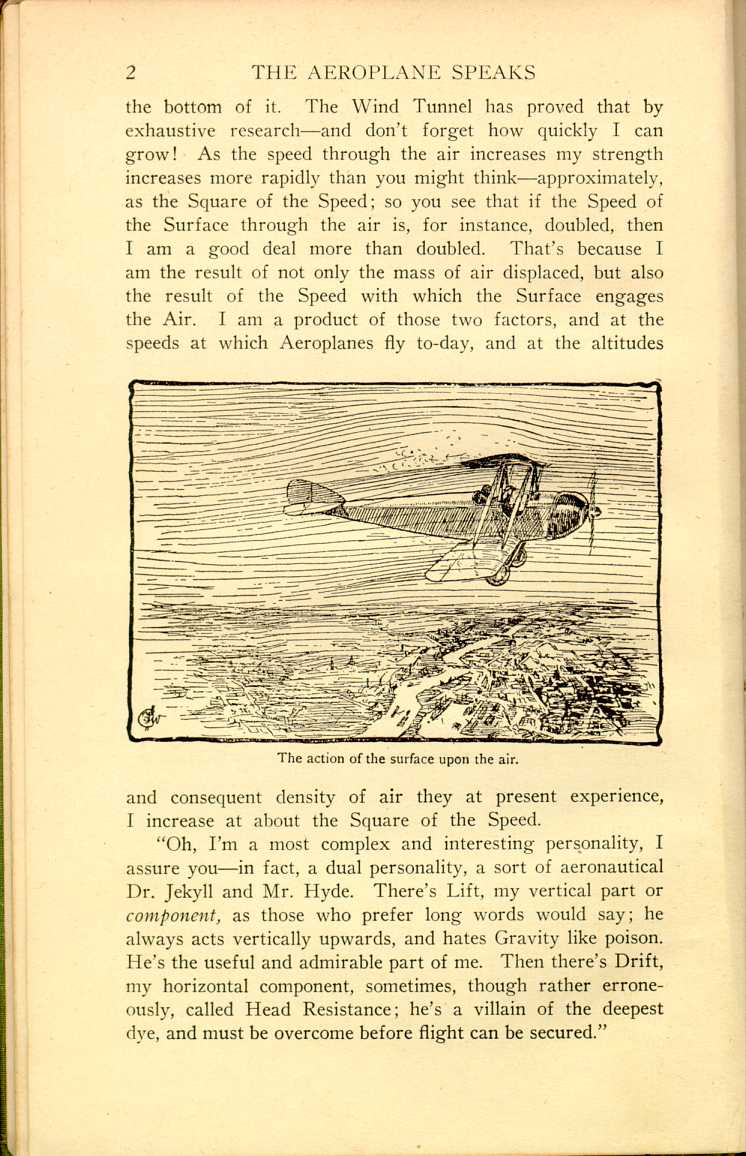
The action of the surface upon the air.
[Description: Illustration representing the aerodynamics of the plane's surface. ]"Oh, I'm a most complex and interesting personality, I assure you—in fact, a dual personality, a sort of aeronautical Dr. Jekyll and Mr. Hyde. There's Lift, my vertical part or component, as those who prefer long words would say; he always acts vertically upwards, and hates Gravity like poison. He's the useful and admirable part of me. Then there's Drift, my horizontal component, sometimes, though rather erroneously, called Head Resistance; he's a villain of the deepest dye, and must be overcome before flight can be secured."
"And I," said the Propeller, "I screw through the air and produce the Thrust. I thrust the Aeroplane through the air and overcome the Drift; and the Lift increases with the Speed and when it equals the Gravity of Weight, then—there you are—Flight! And nothing mysterious about it at all."
"I hope you'll excuse me interrupting," said a very
beautiful young lady, "my name is Efficiency, and, while
no doubt, all you have said is quite true, and that, as my
young man the Designer says, `You can make a tea-tray
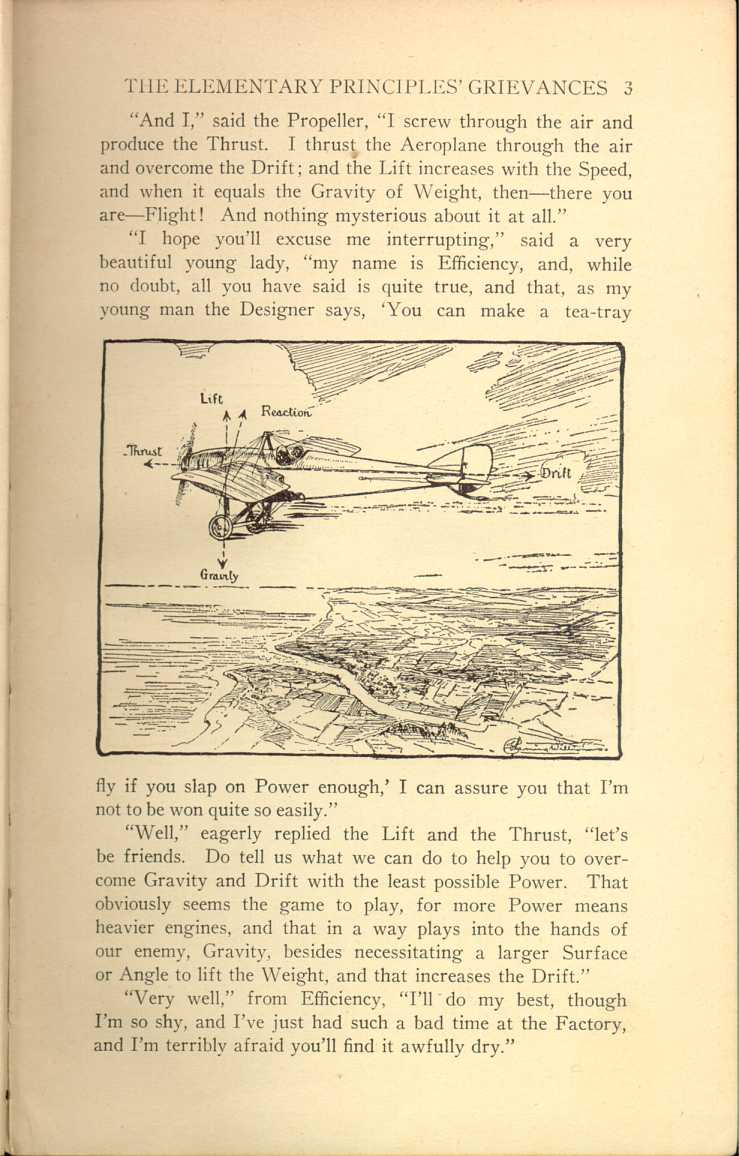 [Description: Illustration depicting the forces of lift, drift, thrust and gravity.
]
[Description: Illustration depicting the forces of lift, drift, thrust and gravity.
]
"Well," eagerly replied the Lift and the Thrust, "let's be friends. Do tell us what we can do to help you to overcome Gravity and Drift with the least possible Power. That obviously seems the game to play, for more Power means heavier engines, and that in a way plays into the hands of our enemy, Gravity, besides necessitating a larger Surface or Angle to lift the Weight, and that increases the Drift."
"Very well," from Efficiency, "I'll do my best, though I'm so shy, and I've just had such a bad time at the Factory, and I'm terribly afraid you'll find it awfully dry."
"Buck up, old dear!" This from several new-comers, who had just appeared. "We'll help you," and one of them, so lean and long that he took up the whole height of the lecture room, introduced himself.
"I'm the High Aspect Ratio," he said, "and what we
have got to do to help this young lady is to improve the
proportion of Lift to Drift. The more Lift we can get for a
certain area of Surface, the greater the Weight the latter
can carry; and the less the Drift, then the less Thrust and
Power required to overcome it. Now it is a fact that, if
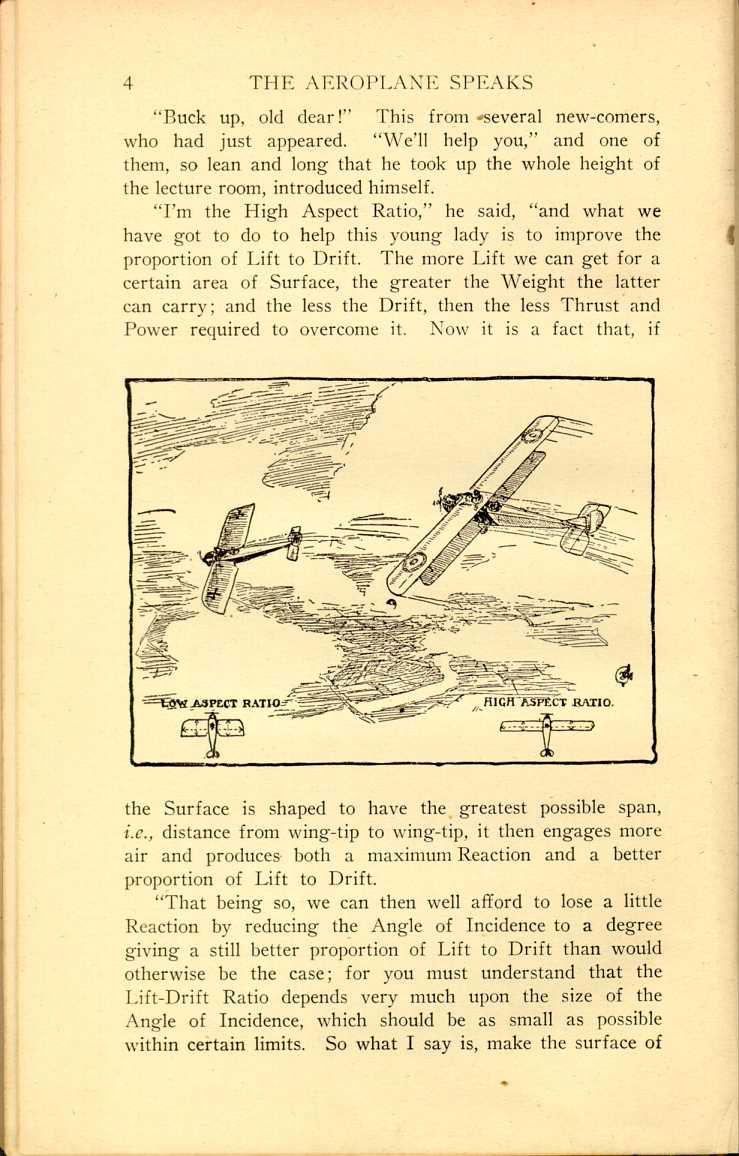 [Description:
Illustration demonstrating low and high aspect ratio.
]
[Description:
Illustration demonstrating low and high aspect ratio.
]
"That being so, we can then well afford to lose a little Reaction by reducing the Angle of Incidence to a degree giving a still better proportion of Lift to Drift than would otherwise be the case; for you must understand that the Lift-Drift Ratio depends very much upon the size of the Angle of Incidence, which should be as small as possible within certain limits. So what I say is, make the surface of
"That's not practical politics," said the Surface. "The
way you talk one would think you were drawing £400 a
year at Westminster, and working up a reputation as an
Aeronautical Expert. I must have some depth and chord
to take my Spars and Ribs, and again, I must have a certain
chord to make it possible for my Camber (that's curvature)
to be just right for the Angle of Incidence. If that's not
right the air won't get a nice uniform compression and
downward acceleration from my underside, and the rarefied
`suction' area over the top of me will not be as even and clean
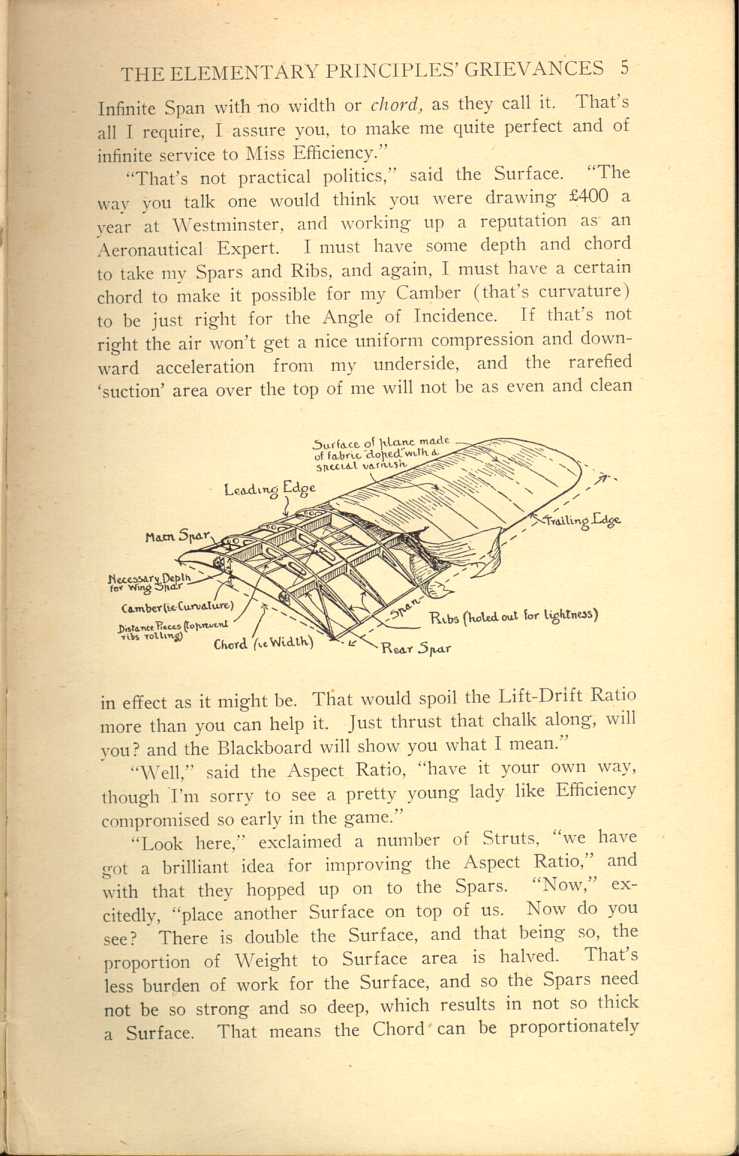 [Description:
Illustration of a portion of a wing, cross-sectioned and labeled.
]
[Description:
Illustration of a portion of a wing, cross-sectioned and labeled.
]
"Well," said the Aspect Ratio, "have it your own way, though I'm sorry to see a pretty young lady like Efficiency compromised so early in the game."
"Look here," exclaimed a number of Struts, "we have got a brilliant idea for improving the Aspect Ratio," and with that they hopped up on to the Spars. "Now," excitedly, "place another Surface on top of us. Now do you see? There is double the Surface, and that being so, the proportion of Weight to Surface area is halved. That's less burden of work for the Surface, and so the Spars need not be so strong and so deep, which results in not so thick a Surface. That means the Chord can be proportionately
"I don't deny that they have rather got me there," said the Drift, "but all the same, don't forget my increase due to the drift of the Struts and their bracing wires."
"Yes, I dare say," replied the Surface, "but remember that my Spars are less deep than before, and consequently I am not so thick now, and shall for that reason also be able to go through the air with a less proportion of Drift to Lift."
"Remember me also, please," croaked the Angle of Incidence. "Since the Surface has now less weight to carry for its area, I may be set at a still lesser and finer Angle. That means less Drift again. We are certainly getting on splendidly! Show us how it looks now, Blackboard." And the Blackboard obligingly showed them as follows:
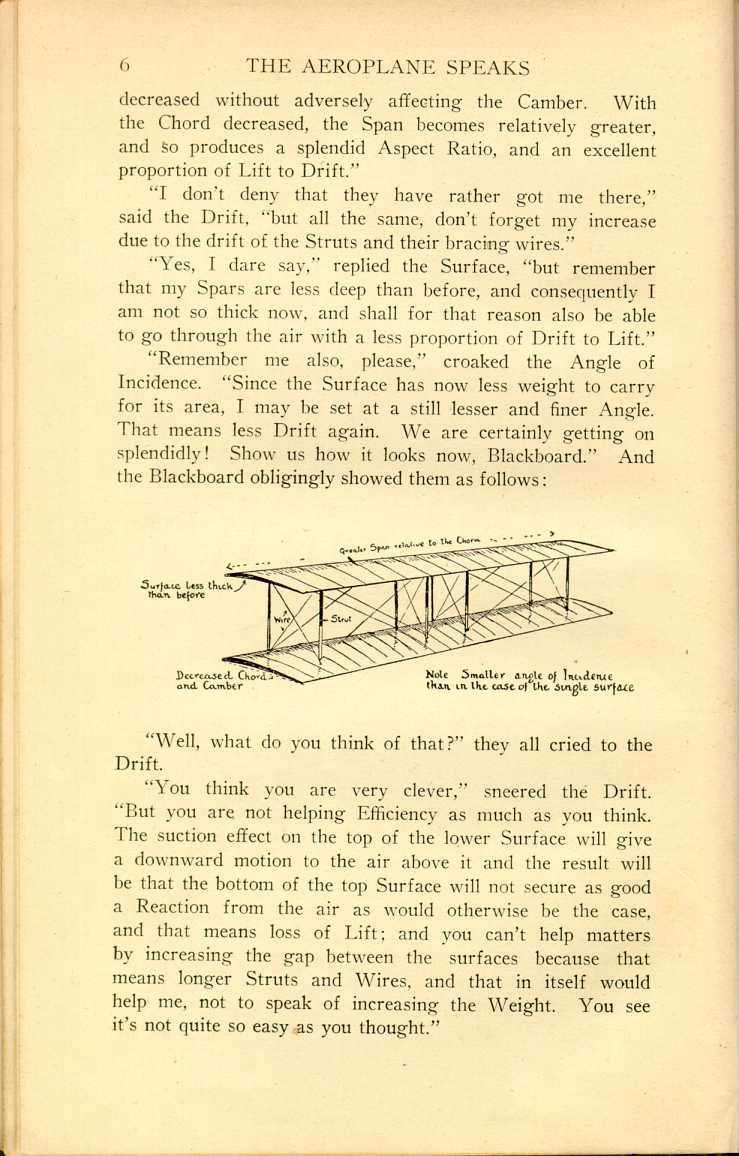 [Description:
Illustration of wings.
]
[Description:
Illustration of wings.
]
"Well, what do you think of that?" they all cried to the Drift.
"You think you are very clever," sneered the Drift. "But you are not helping Efficiency as much as you think. The suction effect on the top of the lower Surface will give a downward motion to the air above it and the result will be that the bottom of the top Surface will not secure as good a Reaction from the air as would otherwise be the case, and that means loss of Lift; and you can't help matters by increasing the gap between the surfaces because that means longer Struts and Wires, and that in itself would help me, not to speak of increasing the Weight. You see it's not quite so easy as you thought."
At this moment a hiccough was heard, and a rather fast and rakish-looking chap, named Stagger, spoke up. "How d'ye do, miss," he said politely to Efficiency, with a side glance out of his wicked old eye. "I'm a bit of a knut, and without the slightest trouble I can easily minimize the disadvantage that old reprobate Drift has been frightening you with. I just stagger the top Surface a bit forward, and no longer is that suction effect dead under it. At the same time I'm sure the top Surface will kindly extend its Span for such distance as its Spars will support it without the aid of Struts. Such extension will be quite useful, as there will be no Surface at all underneath it to interfere with the Reaction above." And the Stagger leaned forward and picked up the Chalk, and this is the picture he drew:
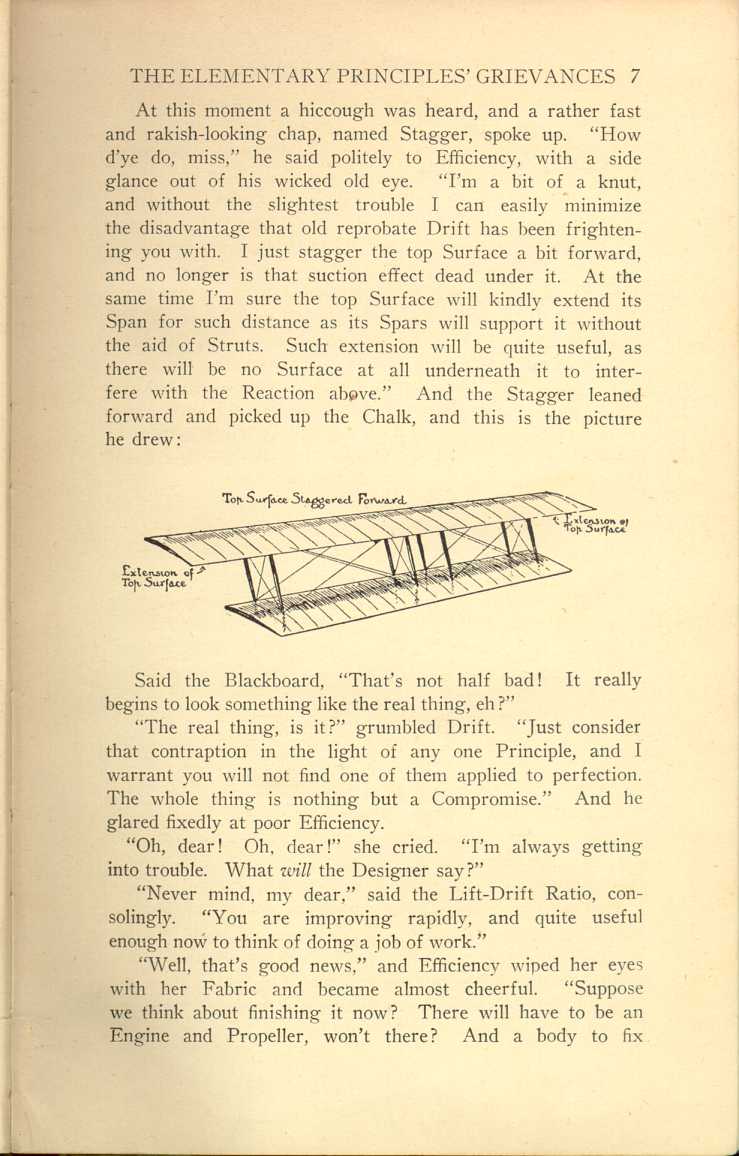 [Description:
Illustration of wings with the top surface staggered forward.
]
[Description:
Illustration of wings with the top surface staggered forward.
]
Said the Blackboard, "That's not half bad! It really begins to look something like the real thing, eh?"
"The real thing, is it?" grumbled Drift. "Just consider that contraption in the light of any one Principle, and I warrant you will not find one of them applied to perfection. The whole thing is nothing but a Compromise." And he glared fixedly at poor Efficiency.
"Oh, dear! Oh, dear!" she cried. "I'm always getting into trouble. What will the Designer say?"
"Never mind, my dear," said the Lift-Drift Ratio, consolingly. "You are improving rapidly, and quite useful enough now to think of doing a job of work."
"Well, that's good news," and Efficiency wiped her eyes with her Fabric and became almost cheerful. "Suppose we think about finishing it now? There will have to be an Engine and Propeller, won't there? And a body to fix
"Well, we are getting within sight of those interesting Factors," said the Lift-Drift Ratio, "but first of all we had better decide upon the Area of the Surfaces, their Angle of Incidence and Camber. If we are to ascend as quickly as possible the Aeroplane must be slow in order to secure the best possible Lift-Drift Ratio, for the drift of the struts wires, body, etc., increases approximately as the square of the speed, but it carries with it no lift as it does in the case of the Surface. The less speed then, the less such drift, and the better the Aeroplane's proportion of lift to drift; and, being slow, we shall require a large Surface in order to secure a large lift relative to the weight to be carried. We shall also require a large Angle of Incidence relative to the horizontal, in order to secure a proper inclination of the Surface to the direction of motion, for you must remember that, while we shall fly upon an even keel and with the propeller thrust horizontal (which is its most efficient attitude), our flight path, which is our direction of motion, will be sloping upwards, and it will therefore be necessary to fix the Surface to the Aeroplane at a very considerable angle relative to the horizontal Propeller Thrust in order to secure a proper angle to the upwards direction of motion. Apart from that, we shall require a larger Angle of Incidence than in the case of a machine designed purely for speed, and that means a correspondingly large Camber.
"On the other hand, if we are thinking merely of Speed, then a Small Surface, just enough to lift the weight off the ground, will be best, also a small Angle to cut the Drift down and that, of course, means a relatively small Camber.
"So you see the essentials for Climb or quick ascent and for Speed are diametrically opposed. Now which is it to be?"
"Nothing but perfection for me," said Efficiency. "What I want is Maximum Climb and Maximum Speed for the Power the Engine produces."
And each Principle fully agreed with her beautiful sentiments, but work together they would not.
The Aspect Ratio wanted infinite Span, and hang the Chord.
The Angle of Incidence would have two Angles and two Cambers in one, which was manifestly absurd; the Surface insisted upon no thickness whatever, and would not hear of such things as Spars and Ribs; and the Thrust objected to anything at all likely to produce Drift, and very nearly wiped the whole thing off the Blackboard.
There was, indeed, the makings of a very pretty quarrel when the Letter arrived. It was about a mile long, and began to talk at once.
"I'm from the Inventor," he said, and hope rose in the
heart of each heated Principle. "It's really absurdly simple.
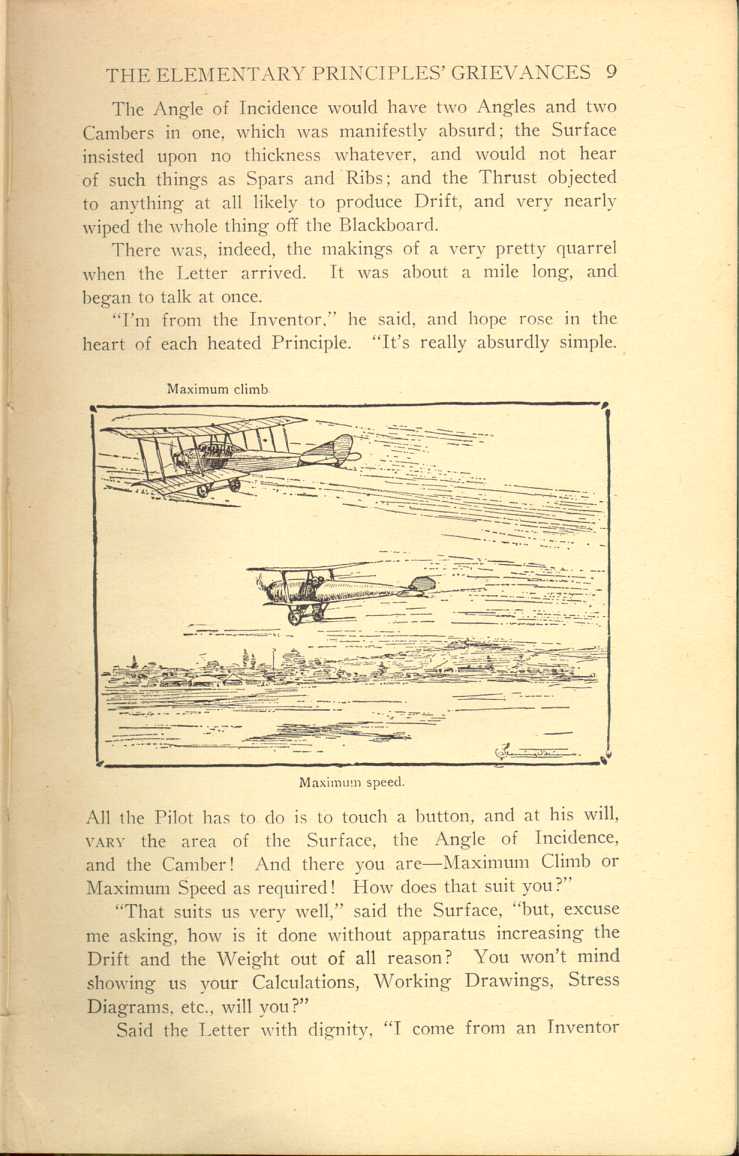
Maximum climb. Maximum speed.
[Description:
Illustration demonstrating maximum climb and maximum speed.
]
"That suits us very well," said the Surface, "but, excuse me asking, how is it done without apparatus increasing the Drift and the Weight out of all reason? You won't mind showing us your Calculations, Working Drawings, Stress Diagrams, etc., will you?"
Said the Letter with dignity, "I come from an Inventor
"Look here," said a Strut, rather pointedly, "where do you think you are going, anyway?"
"Well," from the Letter, "as a matter of fact, I'm not addressed yet, but, of course, there's no doubt I shall reach the very highest quarters and absolutely revolutionize Flight when I get there."
Said the Chalk, "I'll address you, if that's all you want; now drift along quickly!" And off went the Letter to The Technical Editor, "Daily Mauler," London.
And a League was formed, and there were Directors with Fees, and several out-of-service Tin Hats, and the Man-who-takes-the-credit, and a fine fat Guinea-pig, and all the rest of them. And the Inventor paid his Tailor and had a Hair-Cut, and is now a recognized Press Expert—but he is still waiting for those Mechanics!
"I'm afraid," said the Slide-rule, who had been busy making those lightning-like automatic calculations for which he is so famous, "it's quite impossible to fully satisfy all of you, and it is perfectly plain to me that we shall have to effect a Compromise and sacrifice some of the Lift for Speed."
Thud! What was that?
Efficiency had fainted dead away! The last blow had been too much for her. And the Principles gathered mournfully round, but with the aid of the Propeller Slip[1] and a friendly lift from the Surface she was at length revived and regained a more normal aspect.
Said the Stagger with a raffish air, "My dear young lady, I assure you that from the experiences of a varied career, I have learned that perfection is impossible, and I am sure the Designer will be quite satisfied if you become the Most Efficient Compromise."
"Well, that sounds so common sense," sighed Efficiency, "I suppose it must be true, and if the Designer is satisfied,
So the Chalk drew a nice long slim body to hold the
Engine and the tanks, etc., with room for the Pilot's and
Passenger's seats, and placed it exactly in the middle of the
Biplane. And he was careful to make its position such that
the Centre of Gravity was a little in advance of the Centre
of Lift, so that when the Engine was not running and there
was consequently no Thrust, the Aeroplane should be "nose-heavy"
just to the right degree, and so take up a natural
glide to Earth—and this was to help the Pilot and relieve
him of work and worry, should he find himself in a fog or
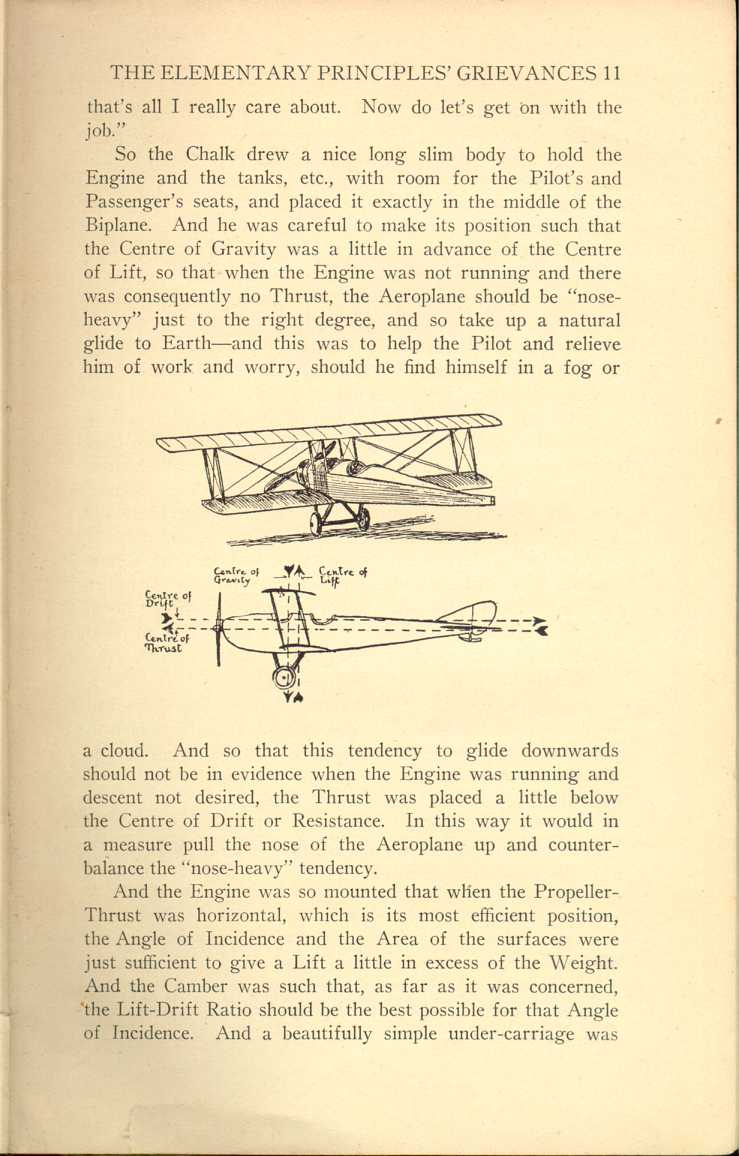 [Description:
Rear and side views of a biplane, demonstrating the forces of lift, drift, thrust and gravity.
]
[Description:
Rear and side views of a biplane, demonstrating the forces of lift, drift, thrust and gravity.
]
And the Engine was so mounted that when the Propeller-Thrust was horizontal, which is its most efficient position, the Angle of Incidence and the Area of the surfaces were just sufficient to give a Lift a little in excess of the Weight. And the Camber was such that, as far as it was concerned, the Lift-Drift Ratio should be the best possible for that Angle of Incidence. And a beautifully simple under-carriage was
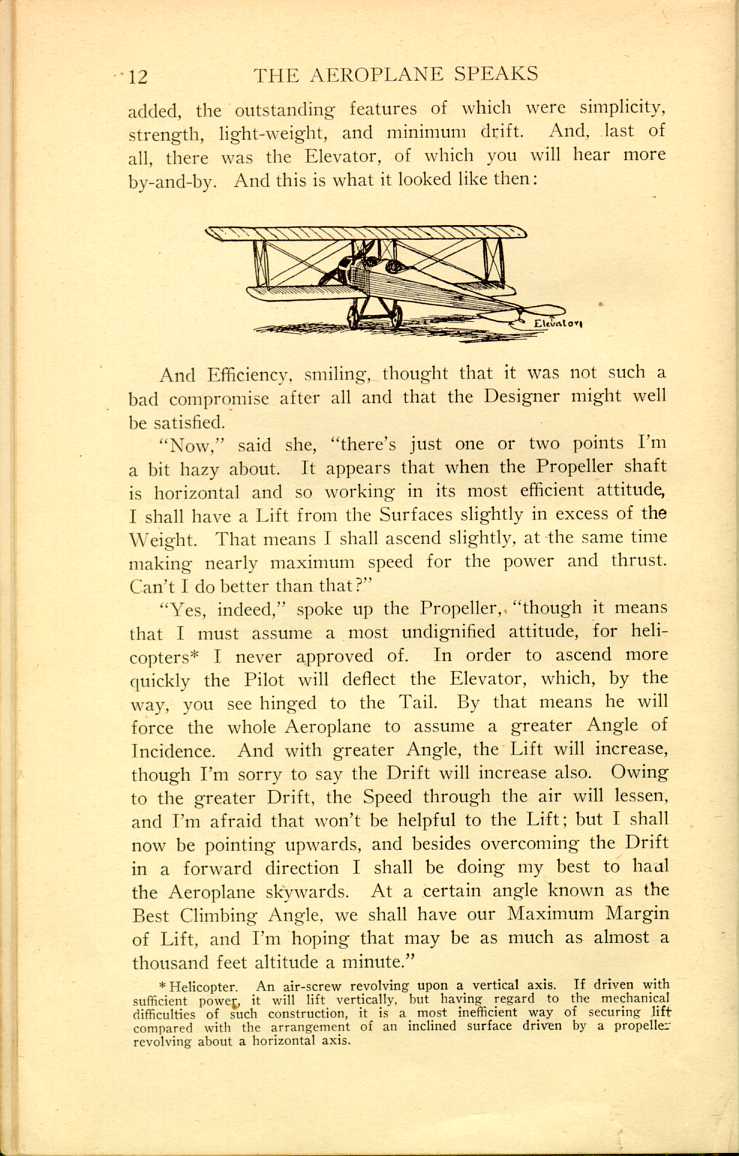 [Description:
Rear view of a biplane in which the elevators are labeled.
]
[Description:
Rear view of a biplane in which the elevators are labeled.
]
And Efficiency, smiling, thought that it was not such a bad compromise after all and that the Designer might well be satisfied.
"Now," said she, "there's just one or two points I'm a bit hazy about. It appears that when the Propeller shaft is horizontal and so working in its most efficient attitude, I shall have a Lift from the Surfaces slightly in excess of the Weight. That means I shall ascend slightly, at the same time making nearly maximum speed for the power and thrust. Can't I do better than that?"
"Yes, indeed," spoke up the Propeller, "though it means that I must assume a most undignified attitude, for helicopters[2] I never approved of. In order to ascend more quickly the Pilot will deflect the Elevator, which, by the way, you see hinged to the Tail. By that means he will force the whole Aeroplane to assume a greater Angle of Incidence. And with greater Angle, the Lift will increase, though I'm sorry to say the Drift will increase also. Owing to the greater Drift, the Speed through the air will lessen, and I'm afraid that won't be helpful to the Lift; but I shall now be pointing upwards, and besides overcoming the Drift in a forward direction I shall be doing my best to haul the Aeroplane skywards. At a certain angle known as the Best Climbing Angle, we shall have our Maximum Margin of Lift, and I'm hoping that may be as much as almost a thousand feet altitude a minute."
"Then, if the Pilot is green, my chance will come," said the Maximum Angle of Incidence. "For if the Angle is increased over the Best Climbing Angle, the Drift will rush up; and the Speed, and with it the Lift, will, when my Angle is reached, drop to a point when the latter will be no more than the Weight. The Margin of Lift will have entirely disappeared, and there we shall be, staggering along at my tremendous angle, and only just maintaining horizontal flight."
"And then with luck I'll get my chance," said the Drift.
"If he is a bit worse than green, he'll perhaps still further
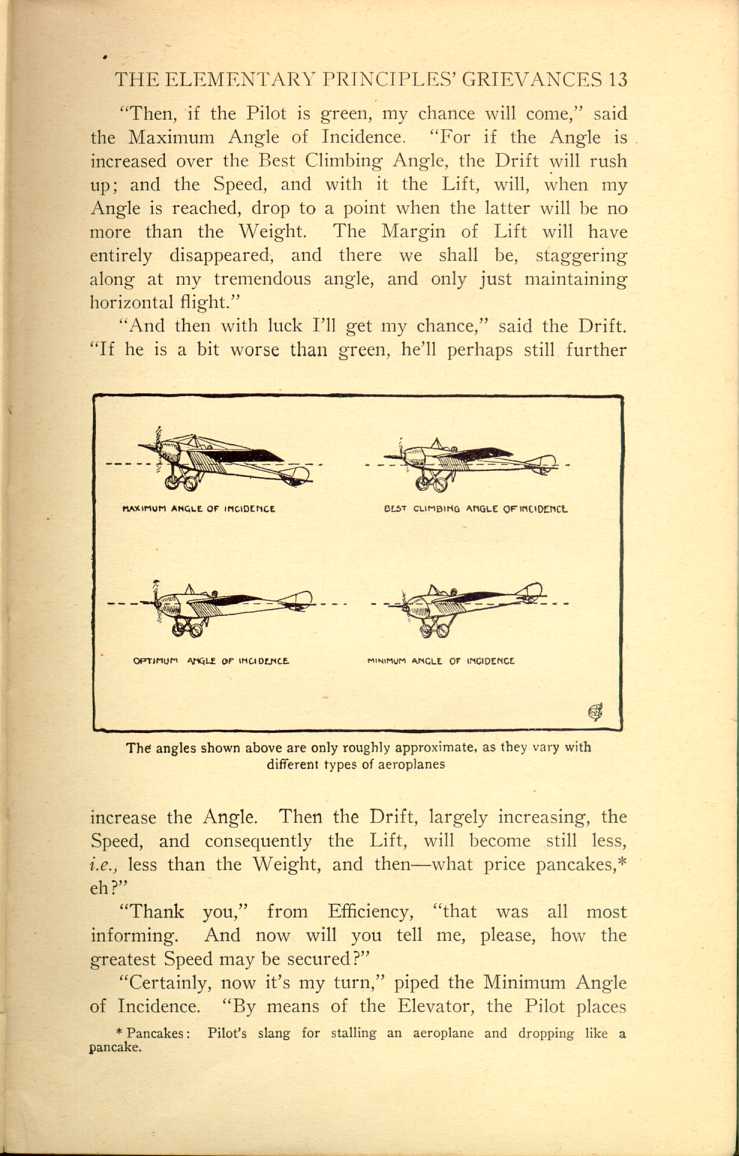
The angles shown above are only roughly approximate, as they vary
with different types of aeroplanes
[Description:
Illustration depicting different angles of incidence.
]
"Thank you," from Efficiency, "that was all most informing. And now will you tell me, please, how the greatest Speed may be secured?"
"Certainly, now it's my turn," piped the Minimum Angle of Incidence. "By means of the Elevator, the Pilot places
"Yes; though I'm out of the horizontal and thrusting downwards," grumbled the Propeller, "and that's not efficient, though I suppose it's the best we can do until that Inventor fellow finds his Mechanics."
"Thank you so much," said Efficiency. "I think I have now at any rate an idea of the Elementary Principles of Flight, and I don't know that I care to delve much deeper, for sums always give me a headache; but isn't there something about Stability and Control? Don't you think I ought to have a glimmering of them too?"
"Well, I should smile," said a spruce Spar, who had come all the way from America. "And that, as the Lecturer says, `will be the subject of our next lecture,' so be here again to-morrow, and you will be glad to hear that it will be distinctly more lively than the subject we have covered to-day."
Propeller Slip: As the propeller screws through the air, the latter to a certain extent gives back to the thrust of the propellor blades, just as the shingle on the beach slips back as you ascend it. Such "give-back" is known as "slip," and anyone behind the propellor will feel the slip as a strong draught of air.
Helicopter. An air-screw revolving upon a vertical axis. If driven with sufficient power, it will lift vertically, but having regard to the mechanical difficulties of such construction, it is a most inefficient way of securing lift compared with the arrangement of an inclined surface driven by a propeller revolving about a horizontal axis.
| The Aeroplane Speaks | ||